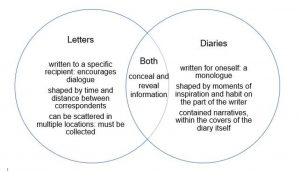Estimated time to complete this section: 38 minutes
Personal letters and diaries present possibilities for analysis as both literary works and as historical evidence. These documents, reflecting the candid thoughts, feelings, and observations of their authors, can provide a new perspective to local history narratives.
Letters and diaries share some points of difference, and one important similarity, as illustrated in the diagram below:
While letters and diaries provide first-person evidence of the past, it is critical to remember that they are also the creations of literate people who had the financial resources, time, space, and tools in order to write, reflect, and respond to the world around them. As technology becomes more accessible over time, library holdings may also include letters and diaries in audio and video formats; however, the considerations of time, space, and tools remain. This understanding will also aid in analyzing these documents, regardless of format.
3.3 Videos
- Women’s Rights: Sarah Bagley’s Letters (Total Video Time = 9:02; video transcripts on page)
- The Iran Hostage Crisis: Diary of Robert Ode (Total Video Time-all 4 segments: 27:11; video transcripts on page )
| Considering Materiality: Thinking about the tangible components of letters and diaries | If you have access to the original letters or diaries
|
| Considering Creation & Dimension: Thinking about the letter writers and diarists, and the ways letters and diaries are impacted by time |
|
| Considering Portrayals: Thinking about the ways in which letter writers and diarists write about events, relationships, and themselves |
|
| Considering Corroboration: Thinking about questions of time and position |
|
adapted from Steven Stowe, “Making Sense of Letters and Diaries,” History Matters: The U.S. Survey Course on the Web, http://historymatters.gmu.edu/mse/letters/, July 2002.
